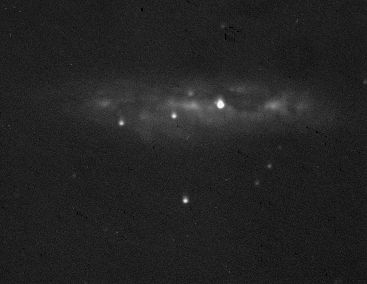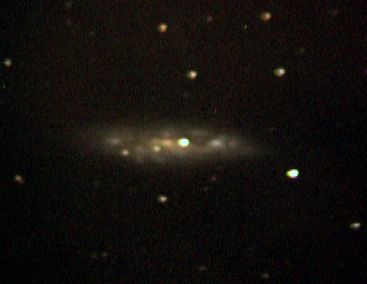

Although M108 is classified as a type Sc spiral galaxy, even large-scale images show little of a spiral character This is because we are seeing it almost edge on, and it seems to contain quite a lot of dark material which breaks up its spiral pattern. There is little evidence of a central bulge, typical of most spiral galaxies.
It was discovered by Pierre Méchain on 19th February 1781, but was not included in Messier's catalogue, so was independently discovered by William Herschel on 17th April 1789. It was finally added to Charles Messier's catalogue by Owen Gingerich in 1953. It is about 45 million light-years away and receding at 772 km/sec. It subtends angles of 8.6 by 2.4 arc-minutes.
 |
My first attempt at this faint galaxy. The galaxy barely showed over the light pollution but the Starlight Xpress capture software also includes some useful enhancement tools. These include background subtraction, which makes the background black, and a non-linear stretch, which behaves like a positive gamma correction. Use of these tools at the telescope convinced me that I could resolve the galaxy from the background and that a longer exposure would be of no help because the background was giving a significant signal. However I had to apply these tools (background, stretch, and a second background) to each frame before using K3CCDTools to align and stack them. Date and Time: 2nd April 2009 00:48 to 01:29 UT Camera: MX716 Telescope: LX200 at prime focus. Capture: Star_mx7_usb. 20 frames, 120" exposure. Pre-pocessing: Star_mx7_usb, background subtraction, non-linear stretch. Processing: K3CCDTools. 14 frames stacked, histogram 12-94. Post-processing: PhotoImpact. Gamma 1.5, brightness -10. |
||||
 |
My first attempt to make a colour picture of this galaxy. It was made using my monochrome MX716 camera with Astonomik RGB filters. I only had time for two exposures with each filter and light polution gave the red image a very bright background. Each raw image was enhanced the same way as the one above and summed with its pair in the star_mx7_usb software. These three images were then combined in RegiStax to produce the full-colour image. Because of the light polution, the resulting picture had a red glow, so I removed this using the slider in the RGB-balance feature in RegiStax, but some of the outlying stars still look a little pink. I was able to use the above image and this one to work out what reduction the focal reducer was giving me. (It varies depending on the distance from the lens to the camera chip.) The above image was made with the camera in its low-resolution mode so the image is intrinsicly half the size of this picture. By measuring the distance between two stars in the two pictures I was able to determine that the reduction was 0.30; very close to the nominal 0.33, so I have the camera close to its ideal separation from the lens. Date and Time: 15th May 2010 21:53 to 22:09 UT Camera: MX716 in full-resolution mode Telescope: LX200 with 0.33 focal reducer. Capture: Star_mx7_usb. 2 frames at each colour, 120" exposure. Pre-pocessing: Star_mx7_usb, background subtraction, non-linear stretch, summation of pairs. Processing: RegiStax. 3 frames stacked, colour balance. |
||||
Home Back to DSOs